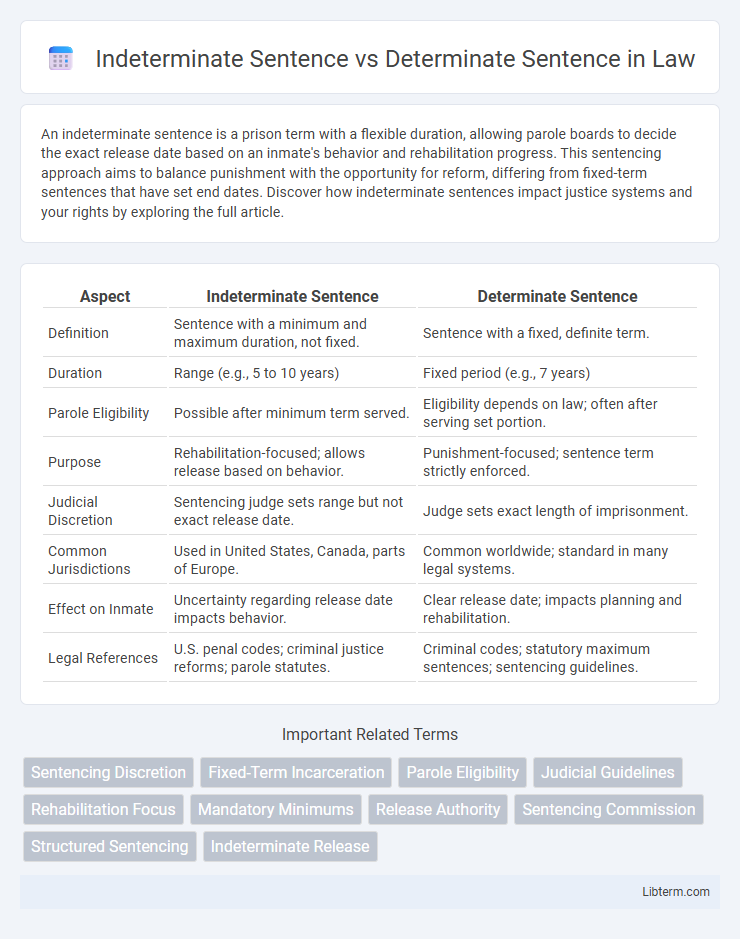An indeterminate sentence is a prison term with a flexible duration, allowing parole boards to decide the exact release date based on an inmate's behavior and rehabilitation progress. This sentencing approach aims to balance punishment with the opportunity for reform, differing from fixed-term sentences that have set end dates. Discover how indeterminate sentences impact justice systems and your rights by exploring the full article.
Table of Comparison
| Aspect | Indeterminate Sentence | Determinate Sentence |
|---|---|---|
| Definition | Sentence with a minimum and maximum duration, not fixed. | Sentence with a fixed, definite term. |
| Duration | Range (e.g., 5 to 10 years) | Fixed period (e.g., 7 years) |
| Parole Eligibility | Possible after minimum term served. | Eligibility depends on law; often after serving set portion. |
| Purpose | Rehabilitation-focused; allows release based on behavior. | Punishment-focused; sentence term strictly enforced. |
| Judicial Discretion | Sentencing judge sets range but not exact release date. | Judge sets exact length of imprisonment. |
| Common Jurisdictions | Used in United States, Canada, parts of Europe. | Common worldwide; standard in many legal systems. |
| Effect on Inmate | Uncertainty regarding release date impacts behavior. | Clear release date; impacts planning and rehabilitation. |
| Legal References | U.S. penal codes; criminal justice reforms; parole statutes. | Criminal codes; statutory maximum sentences; sentencing guidelines. |
Introduction to Sentencing Types
Indeterminate sentences provide a flexible time frame for incarceration, allowing parole boards to determine release based on rehabilitation and behavior, typically ranging from a minimum to a maximum period. Determinate sentences impose a fixed, definite duration of imprisonment, ensuring offenders serve a specified length of time without early release discretion. These sentencing types influence correctional strategies and the management of inmate populations in criminal justice systems.
What is an Indeterminate Sentence?
An indeterminate sentence is a type of criminal punishment without a fixed duration, allowing parole boards to decide the release date based on the inmate's rehabilitation progress and behavior. It contrasts with a determinate sentence, which has a specific, predetermined length of incarceration defined by the court. The flexibility of indeterminate sentencing aims to incentivize rehabilitation and reduce recidivism by tailoring the punishment period to individual circumstances.
Understanding Determinate Sentences
Determinate sentences specify a fixed prison term, such as 10 or 20 years, with little flexibility for early release, ensuring clarity and consistency in punishment. These sentences are prevalent in jurisdictions favoring predictability in sentencing and reducing judicial discretion, facilitating straightforward parole eligibility and sentence management. Understanding determinate sentences helps grasp how legal systems balance punishment severity with procedural certainty.
Key Differences: Indeterminate vs Determinate Sentences
Indeterminate sentences impose a range of punishment, allowing parole eligibility after serving a minimum term, while determinate sentences specify a fixed duration without early release options. Indeterminate sentencing emphasizes rehabilitation and judicial flexibility, whereas determinate sentencing prioritizes consistency and certainty in punishment length. The choice between these sentences impacts parole potential, sentencing discretion, and overall correctional policy outcomes.
Legal Framework and Statutory Guidelines
Indeterminate sentences allow parole boards to set inmates' release dates within a legal range, promoting rehabilitation and individualized assessment under statutes like the U.S. Model Penal Code and various state laws. Determinate sentences prescribe fixed terms mandated by sentencing guidelines and statutory mandates, limiting judicial discretion and ensuring consistent punishment. Legal frameworks emphasize balancing public safety with offender reintegration, with statutory guidelines defining eligibility criteria, sentence lengths, and review processes unique to each sentencing type.
Pros and Cons of Indeterminate Sentences
Indeterminate sentences offer judicial flexibility by allowing parole boards to assess inmate rehabilitation and release timing based on behavior and progress, promoting individualized justice. However, they can lead to uncertainty and potential inconsistencies in sentencing outcomes, potentially prolonging incarceration without a definitive release date. Critics argue this lack of fixed terms may undermine transparency and complicate case management for both inmates and legal authorities.
Advantages and Disadvantages of Determinate Sentences
Determinate sentences provide clear, fixed terms of imprisonment, enhancing transparency and consistency within the legal system. This structure limits judicial discretion, which can reduce disparities in sentencing but may also restrict opportunities for rehabilitation tailored to individual offenders. Critics argue that determinate sentences may contribute to prison overcrowding and fail to account for personal circumstances, potentially leading to unjust outcomes.
Impact on Rehabilitation and Parole
Indeterminate sentences offer a flexible framework that supports rehabilitation by allowing parole boards to assess an inmate's progress and potential for reintegration into society, tailoring release timing based on individual reform. Determinate sentences impose fixed incarceration periods, which may limit opportunities for early parole and reduce incentives for rehabilitation efforts, as release dates are predetermined regardless of behavior or treatment participation. The indeterminate approach tends to promote more personalized rehabilitation outcomes and can reduce recidivism through structured parole evaluation focused on readiness for reentry.
Real-World Examples and Case Studies
Indeterminate sentences, such as those used in the United States, allow parole boards to decide release dates based on inmate behavior and rehabilitation progress, exemplified by California's use of indeterminate sentencing for various crimes. In contrast, determinate sentences specify fixed prison terms, as seen in the mandatory minimum sentences implemented in federal drug offenses, restricting judicial discretion to enforce consistent punishment. Case studies from New York show that determinate sentencing can reduce sentence disparities but may increase prison populations due to less flexibility in early release decisions.
Frequently Asked Questions on Sentencing Types
Indeterminate sentences set a minimum and maximum duration, allowing parole boards to decide release based on rehabilitation progress, while determinate sentences specify a fixed term with little flexibility for early release. Frequently asked questions about these sentencing types often concern eligibility for parole, the impact on rehabilitation opportunities, and differences in how sentence length influences incarceration time. Understanding the distinctions helps clarify legal outcomes, prisoner rights, and sentencing fairness within criminal justice systems.
Indeterminate Sentence Infographic

 libterm.com
libterm.com